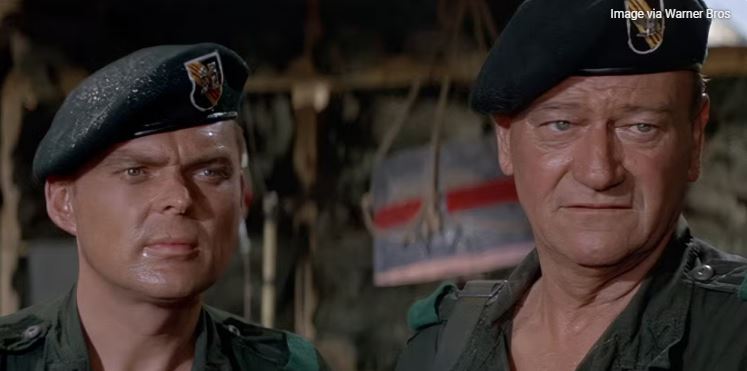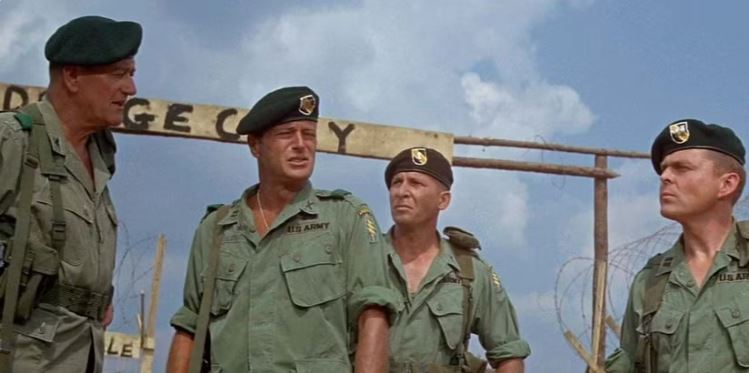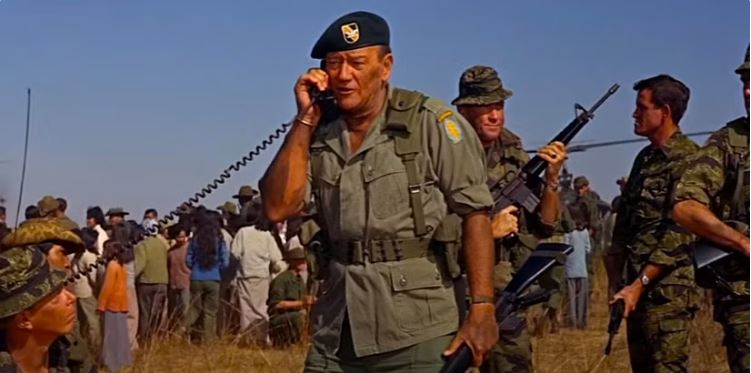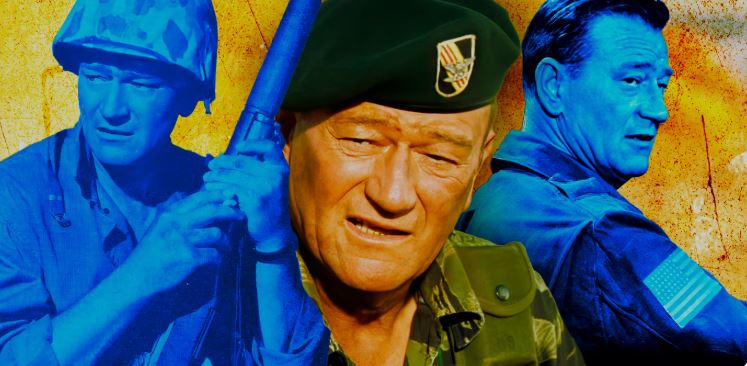Nearly 50 years after his final film, John Wayne remains one of the most beloved action stars in film history. His Golden Age performances won him the flattering nickname “The Duke,” and many of his titles are still beloved today. That said, with over 170 film credits, not all of his roles are necessarily good. Take, for instance, that time in the late 1960s, when Wayne swapped his acting role for a director’s chair. He teamed up with the much lesser-known Ray Kellog to create The Green Berets. On the surface, it’s far from unconventional. It’s a run-of-the-mill Vietnam War film released at the height of said conflict. Like many militaristic films, it had support from the United States government. It was even a box office hit, earning its studio over $20 million.
However, in reality, The Green Berets was a critical pariah. The esteemed Roger Ebert awarded the film zero stars and deemed it one of his “Most Hated” films of all time. San Francisco Examiner’s Stanley Eichelbaum dubbed Wayne’s film “the phoniest, most laughable war picture in many years.” And — before anyone objects — the collective cold shoulder wasn’t just a case of “Hollywood politics.”
John Wayne’s The Green Berets Is One of the Most Critically Panned Films of the 1960s

Unlike some war films, The Green Berets is a primarily fictitious battlefield romp. It revels in violence and the inherent “glory” of war. Its lead, Colonel Mike Kirby (John Wayne), is the quintessential badass soldier. He has the combat skills necessary to survive on the battlefield and a lovable “heart of gold” mentality.
He and his fellow soldiers — who generally act as Wayne’s supporting cast and living props — endure the hardships of Vietnam. They suffer in the humid heat and witness atrocities committed by the Vietcong. During their travels, they even rescue a war orphan, Hamchunk, and his dog.
The bog-standard plot is easy to follow and unabashedly simple. The Vietcong are the villains; the South Vietnamese and Americans are the heroes. There is no room for debate, and nuance is treated as the ultimate sin. Whenever there may be a drop of sympathy for the “enemies,” the story reminds its audience of the Vietcong’s atrocities. (Of course, America is never in the wrong.)
By the film’s conclusion, the only truly important characters left standing are Hamchunk and — not surprisingly — Mike Kirby. Then, a patriotic poem offers a similarly one-dimensional reflection on the heroism of war and sacrifice. Admittedly, in John Wayne’s defense, America’s involvement in Vietnam would continue for seven years after The Green Berets hit theaters. However, current knowledge only further sours the already controversial film.
A Government-Backed Flop That Aged Like Milk

Colonel Lamar Ashbury “Bill” Welch, an actual military commander, has a cameo role in the film.
Fort Banning, Georgia, was The Green Berets’ primary filming location.
Most of the film was shot before the Tet Offensive dramatically lowered public approval of the Vietnam War.
Not surprisingly, the “rah-rah” patriotism of Wayne’s war film attracted a very powerful backer. The United States military lent plenty of equipment, personnel, and space to the film’s production crew. It even pre-approved the final script. And that tradition is still unnervingly common. Even now, American films often receive military approval to gain access to its excess stock. Otherwise, production teams must finance their own military props and arms.
For many filmmakers, it’s a thorn in their side. John Wayne, ever the war hawk, embraced it as a “tribute.” The Green Berets was his chance to promote his beliefs. Its creation was substantially prompted by his fear of the rising anti-war sentiment. In fact, his only notable objection seemed to be the studio’s emphasis on action over character development. Wayne even sought explicit approval from then-president Lyndon B. Johnson.
While audiences of the period flocked to theaters, the film’s critical reception was abysmal. Arguably, these ruthless criticisms may have spurred an increased interest in The Green Berets. “No promotion is bad promotion,” and Wayne even thanked critics for their free advertising. He likely had the same attitude towards anti-war protests that surrounded the film’s release.
Why The Green Berets Failed

Elmer Bernstein, Wayne’s first choice for composer, refused to work on the film.
In a retrospective review, Ebert rightfully critiqued the film as “shameless propaganda.”
The film’s primary battle is modeled after the Battle of Nom Dong.
But, for the sake of thoroughness, suppose that the film’s inherent political agenda is irrelevant. Even without its imperialistic veneer, Wayne’s war film has all the backbone and substance of wallpaper paste. Everything about the film has aged like milk. Even when one ignores the outcome of the Vietnam War, Wayne’s fanciful view of the chivalrous American soldier is laughably shallow.
Its primarily White cast upholds Wayne’s worldview as much as the script’s dismissive treatment of its “Vietnamese” cast. And, notably, an unsettlingly large chunk of these “foreign allies” aren’t even Vietnamese. In an eye-popping display of racism, the production team was more than happy to pick anyone who even looked vaguely Vietnamese. Colonel Cai, the face of the South Vietnamese forces, is played by Japanese-American actor Jack Soo; likewise, his on-screen compatriot, Captain Nghiem, is George Takei. Cai’s sister-in-law, Lin, is Chinese actress Irene Tsu.
Anything remotely left-of-center is a crime. During the tedious opening, journalist George Beckworth (David Janssen) is promptly humiliated and debased as a “little fellow willing to take the place of those who’ve been decimated.” His punishment for a reasonable question about wartime horror is a self-congratulatory tirade against the censorship and propaganda of the Vietcong. This is, of course, done without an ounce of irony; after all, the American government consistently withheld and manipulated news to cast itself as the surefire victor. (And the same form of manipulation continues today.)
In many ways, The Green Berets is a Western film with a coat of 1960s camo paint. Machine guns replace revolvers, and unambiguously evil Vietcong forces fit the “savage Native” stereotype. Yet, unlike some contemporaneous Westerns, Wayne’s film has neither the motivation nor the narrative space for anything reconciliatory. Kirby is an unambiguous white-hatted lawbringer.
Perhaps, in some ways, Wayne and Kellog should be forgiven for this farcical “war film.” When it debuted, neither the production team nor the film’s audience knew of the atrocities America committed in Vietnam. Both Daniel Lang’s bombshell New Yorker report on wartime casualties and public awareness of the My Lai massacre wouldn’t drop until 1969. Yet, even after these revelations, Wayne never recanted.
Yes, Wayne’s politics and later developments have all but ruined a potentially mediocre war film. The Green Berets is inseparable from its inherently imperialist narrative; its function as mass propaganda is readily apparent.
But perhaps the most brutal condemnation of Wayne’s film is baked in by design. Even without the patriotic outer shell, the film has a weak core. Its dismissive casting and writing make for a deeply unpleasant viewing experience. Certainly, other works of the period had objectionable content; but they also have redeeming qualities. There is no future-proofing of any kind built into The Green Berets. It was and will always be a testament to one man’s fanatical support for the Vietnam War.
